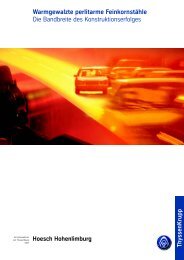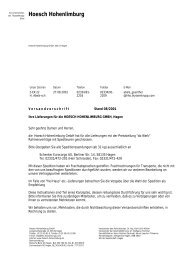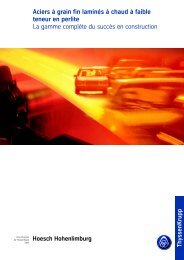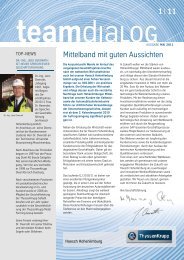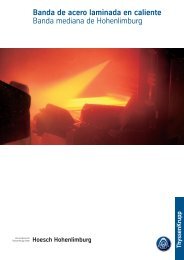Hot Rolled Steel Strip - Hoesch Hohenlimburg
Hot Rolled Steel Strip - Hoesch Hohenlimburg
Hot Rolled Steel Strip - Hoesch Hohenlimburg
Create successful ePaper yourself
Turn your PDF publications into a flip-book with our unique Google optimized e-Paper software.
<strong>Hot</strong> <strong>Rolled</strong> <strong>Steel</strong> <strong>Strip</strong><br />
Company of<br />
ThyssenKrupp<br />
<strong>Steel</strong> <strong>Hoesch</strong> <strong>Hohenlimburg</strong><br />
TK
2<br />
<strong>Hohenlimburg</strong> hot-rolled<br />
narrow steel strip<br />
<strong>Hohenlimburg</strong> narrow steel<br />
strip is produced by hot-rolling<br />
from slabs and available in<br />
widths up to 700 mm and in<br />
thicknesses from 1.5 to 16 mm.<br />
<strong>Hohenlimburg</strong> narrow steel<br />
strip is available with mill<br />
edges, with cut edges slit from<br />
multiple widths, or with trimmed<br />
edges.<br />
It can be supplied in coils weighing<br />
up to 20 kgs/mm strip<br />
width or in bars from 1 to 18 m<br />
in length, pickled, non-pickled,<br />
or heat-treated.<br />
<strong>Hohenlimburg</strong> narrow steel<br />
strip represents the sum of our<br />
more than 100 years of experience<br />
in steel production and<br />
processing. Our narrow-strip<br />
mill has been continuous<br />
modernized over the years and<br />
is now completely processautomated.<br />
There is no<br />
question that it offers the best<br />
prerequisites for achieving<br />
superior tolerances and technological<br />
properties ongoing.<br />
<strong>Hohenlimburg</strong> narrow steel<br />
strip signifies:<br />
• Extremely tight thickness<br />
tolerances<br />
• Optimum symmetric thickness<br />
in profile<br />
• Superior surface quality<br />
• Uniform material properties<br />
• Application-specific microstructures<br />
• Optimum shaping properties<br />
including in higherstrength<br />
steels<br />
• Customized batch sizes<br />
<strong>Hohenlimburg</strong> narrow steel<br />
strip will not only maintain its<br />
qualitative superiority but will<br />
enhance it even further. To<br />
achieve this ambitious goal,<br />
we are making considerable<br />
investments. Our plant and<br />
machinery is state-of-the-art<br />
and guarantees the impressive<br />
product advantages our<br />
<strong>Hohenlimburg</strong> narrow steel<br />
strip is famous for.<br />
<strong>Hohenlimburg</strong> narrow steel<br />
strip is used in nearly all branches<br />
of industry.<br />
As a result of our ongoing<br />
research and development of<br />
our product quality, and based<br />
on our long-standing experience<br />
from listening to our customer´s<br />
needs and requests, we<br />
can now offer a solution to any<br />
problem our customers may<br />
come up with.<br />
You will find our technical application<br />
consultants able to<br />
assist you in your specific<br />
application.<br />
Please contact us.<br />
Hubbalkenofen Walking beam Reversier-Vorstraße<br />
Reversing<br />
furnace<br />
roughing mill<br />
Walking beam furnace<br />
The walking beam furnace<br />
offers optimum prerequisites<br />
for<br />
• Homogenous soaking of<br />
the rolling stock from all<br />
sides.<br />
• High flexibility of the heating<br />
process by eleven<br />
independent temperature<br />
control zones.<br />
• A process-controlled<br />
time/temperature profile<br />
optimally adapted to the<br />
respective material during<br />
the heating-up process.<br />
Reversing roughing mill<br />
The high-capacity universal<br />
reversing mill equipped with<br />
hydraulic gauge and width control<br />
system consists of a horizontal<br />
2-high stand with a flanged-on<br />
edger in front and fully<br />
automatically rolls slabs of a<br />
wide variety of sizes into intermediate<br />
strips.<br />
This means:<br />
• Microstructures with<br />
homogenous density are<br />
achieved by high reduction<br />
ratios.<br />
• Highly effective descaling<br />
assures optimum rough<br />
strip surfaces.<br />
• Computer-controlled rolling<br />
produces geometrically<br />
optimized intermediate<br />
strips.
Narrow steel strip mill<br />
Technical description<br />
Thermal Wärmehauben tunnel Finishing Fertigstraße train Measuring<br />
house<br />
Kühlstrecke Cooling section Haspelanlage<br />
Downcoiler<br />
Thermal tunnel<br />
The thermal tunnel with its<br />
highly effective heat insulation<br />
is configurated to assure that:<br />
• The temperature is rehomogenized<br />
throughout<br />
the cross section profile<br />
(avoidance of edge cooling).<br />
• The essential final rolling<br />
temperature is maintained<br />
at a constant level over the<br />
entire strip length even in<br />
coils with very high specific<br />
weights.<br />
Finishing train<br />
The finishing train consisting<br />
of two 2-high and seven 4-high<br />
stands is equipped with a<br />
high-tech process automation<br />
system developed by ourselves<br />
and offering the following<br />
advantages:<br />
• Extremely narrow thickness<br />
tolerances even at the strip<br />
head of the first coil following<br />
a size/quality change.<br />
• Selective control of strip<br />
camber and flatness by<br />
load distribution strategies<br />
and roll bending.<br />
• Maintaining the specifically<br />
required final rolling temperatures<br />
within narrow limits.<br />
This process is assisted by<br />
an integrated ”speed-up<br />
system“.<br />
The process-automated edgers<br />
installed in front and behind<br />
the 2-high stands are instrumental<br />
in assuring extremely<br />
narrow tolerances in the<br />
finished strip width.<br />
Cooling section<br />
The laminar cooling section<br />
based on specific cooling strategies<br />
and advanced process<br />
automation using neuronal networks<br />
allows:<br />
• Targeted setting of specified<br />
microstructure conditions.<br />
• Achievement of mechanical-technological<br />
properties<br />
with very tight tolerances.<br />
Coiler group<br />
The computer-controlled<br />
coiler group with its base<br />
construction and the possibility,<br />
to adapt the coiling parameter<br />
settings to the various materials,<br />
provides:<br />
• Tight, straight-edged coiling<br />
and, thereby<br />
• the right conditions for processing<br />
without mechanical<br />
damage.<br />
An automatic strapping machine<br />
ties up the coils in the coiling<br />
cellar directly behind the downcoiler<br />
(in longitudinal direction).
4 Production equipment<br />
View into the walking beam furnace<br />
Reversing roughing stand<br />
Thermal tunnel (open) Cooling section<br />
Coiler below floor level<br />
Finishing train
Total view of the pickling line<br />
Parsytec surface spray-pickling system<br />
Total view of slitting line III<br />
Our production is based on<br />
DIN EN 10048/DIN EN 10051<br />
for hot-rolled strip (depending<br />
on the rolling width) and on<br />
DIN 59200 for wide flat steel.<br />
Upon request, we can also<br />
produce to other domestic or<br />
foreign standards. Process<br />
automation allows thickness<br />
tolerances similar to those<br />
applicable for cold-rolled strip.<br />
The cut-to-length lines are<br />
capable of maintaining very<br />
narrow length tolerances for<br />
hot-rolled strip in bars and<br />
plate steel.<br />
Surface conditions with well<br />
picklable homogenous surface<br />
pickled (dry)<br />
pickled and oiled.<br />
A wide range of microstructures<br />
can be produced directly<br />
via the rolling heat.<br />
Additional heat treatments:<br />
• Stress-relief annealing<br />
• Soft annealing<br />
• Spheroidizing on globular<br />
cementite<br />
• Chloric-acid pickling lines<br />
for all cross sections and<br />
qualities produced (continuous<br />
pickling line and<br />
push-pull pickling line).<br />
• Slitting lines (up to cuttingto-length<br />
line including<br />
12 mm thickness).<br />
Tolerances<br />
Surface conditions<br />
Heat treatments<br />
Additional processing<br />
5
6<br />
Mild unalloyed steels and general structural steels<br />
Mild unalloyed steels are delivered<br />
to ENDIN 1614, part 1,<br />
for cold rolling and to DINEN<br />
10111 for direct cold forming<br />
(direct processing of the hotrolled<br />
strip). General structural<br />
steels are standardized to<br />
DIN EN 10025, but are also<br />
available as pre-material for<br />
other products, e.g. steel pipes<br />
for long-distance pipelines, for<br />
flammable liquids and gases to<br />
DIN EN 10208.<br />
Apart from standardized qualities,<br />
we are offering numerous<br />
special qualities optimal adapted<br />
to their intended final use.<br />
In the case of mild unalloyed<br />
steels for direct processing we<br />
have developed special qualities<br />
in addition to grades<br />
DD11, DD12, DD13 to DINEN<br />
10111. For instance, a very<br />
soft quality (now DD14) with<br />
yield points otherwise only<br />
achieved by cold strip, and one<br />
quality with a somewhat higher<br />
tensile strength but still excellent<br />
cold-formability.<br />
Mild unalloyed steels (DINEN 10111:1998)<br />
To replace the no longer produceable<br />
rimming steels, we have<br />
developed a vacuum-killed<br />
deep-drawing quality for casehardening.<br />
This steel contains<br />
only small traces of aluminum<br />
and can (in most cases) be<br />
case-hardened like rimming<br />
steel.<br />
For the deep drawing of shells<br />
and similar structural components<br />
we supply steels with<br />
very low earing characteristics.<br />
That applies for direct processing<br />
as well as after a cold rolling<br />
process. The chemical<br />
composition and the production<br />
parameters are tailored to specifications.<br />
By suitable temperature control<br />
we can produce hot-rolled strip<br />
with a carbon content of less<br />
than 0.20%, with a uniform<br />
fine microstructure suitable for<br />
fine blanking without prior heat<br />
treatment.<br />
Designation Designation Special features<br />
(according to (according to<br />
DINEN 10111) DIN 1614, part 2)<br />
By special rolling processes<br />
and suitable temperature control<br />
we can produce hot-rolled<br />
strip for the production of RP<br />
cold strip surfaces.<br />
General structural steels up to<br />
S 355 with good cold-formability<br />
(chamfering, roll profiling)<br />
can be produced by using a<br />
very low sulphur content and<br />
other measures during steel<br />
production.<br />
In view of their good cold-formability,<br />
we recommend microalloyed<br />
fine grain structural<br />
steels for applications demanding<br />
high yield points and tensile<br />
strengths.<br />
DD14 StW 24 W *) Best cold-formability<br />
DD13 StW 24 Very good cold-formability<br />
DD12 StW 23 Good cold-formability<br />
DD11 StW 22 Basic grade<br />
Increased minimum yield point<br />
— StW 24 H **) and special microstructur to achieve<br />
high endurance values<br />
*) <strong>Hoesch</strong> special quality **) <strong>Hoesch</strong> special quality (increased carbon content compared to StW 24)
Control arm, 2.75mm thick<br />
Shock absorber support,<br />
2.0mm thick<br />
Gear part, monobloc design,<br />
6.5mm thick<br />
Brake piston,<br />
6.0mm thick<br />
Examples of application<br />
Support with outside fins,<br />
4.0mm thick<br />
Brake support plate,<br />
2.25mm thick<br />
Claw for alternator,<br />
10.5mm thick<br />
Trailing arm,<br />
2.5mm thick<br />
7
8 Micro-alloyed low-perlitic fine-grain steels<br />
Nomenclature<br />
These fine-grain steels are fully<br />
killed micro-alloyed steels with<br />
low carbon equivalents. Due to<br />
their chemical composition and<br />
fine-grain microstructure achieved<br />
by thermo-mechanical treatment,<br />
these steels have high<br />
yield points and very good<br />
cold-formability. An even higher<br />
degree of cold-formability<br />
can be achieved by a very low<br />
sulphur content or "sulphide<br />
control", i.e. fixation of the sulphur<br />
to avoid the formation of<br />
undesirable manganese sulphides.<br />
The precisely controlled<br />
production on our hot strip mill<br />
is realized by precise setting of<br />
the rolling temperatures and<br />
reduction rates as well as by<br />
controlled cooling rates and<br />
reel temperatures after rolling.<br />
*) Acc. to the Stahl-Eisen-Liste, 1990 Edition<br />
Our production program includes<br />
N grades which are also<br />
rolled under controlled conditions.<br />
Analysis and temperature<br />
are selected to permit subsequent<br />
normalizing under<br />
specified conditions.<br />
For further details, see our<br />
special brochure.<br />
<strong>Hot</strong>-rolled fine-grain structural<br />
steels are particularly suitable<br />
for direct processing with high<br />
requirements on cold-formability.<br />
This is much more advantageous<br />
than with conventional<br />
structural steels because of the<br />
chemical composition and<br />
microstructure. HSM steels<br />
(<strong>Hoesch</strong> special structural<br />
steels, micro-alloyed) can be<br />
bent with small radii and rolled<br />
into profiles. They can also be<br />
deep-drawn and stretch-formed,<br />
with certain restrictions<br />
in the case of the harder qualities.<br />
These fine-grain steels offer<br />
the engineer good cold-formability<br />
and high yield strengths<br />
at the same time. With other<br />
steels, similar properties can<br />
only be achieved by heat treatment<br />
of the component. The<br />
low-carbon, manganese, and<br />
micro-alloy contents create a<br />
low carbon equivalent and therefore<br />
ensure good weldability.<br />
Only qualities with minimum<br />
yield points of 600 N/mm 2 and<br />
above, and the N grades can<br />
reach a carbon equivalent<br />
comparable to structural steel<br />
of S 355 (DIN EN 10025).<br />
Further details, in particular<br />
with regard to chemical composition<br />
and mechanical properties,<br />
including several potential<br />
applications, are described in<br />
our special brochure.<br />
<strong>Hoesch</strong> designation Material No. Designation in Designation to<br />
Stahl-Eisen-Werkstoff- DIN EN 10 149/2,<br />
blatt 092-90 1995<br />
HSM 260 1.0970* (Q St E 260 TM*) –<br />
HSM 300 1.0972* (Q St E 300 TM*) S 315 MC<br />
HSM 340 1.0974 Q St E 340 TM –<br />
– 1.0976 – S 355 MC<br />
HSM 380 1.0978 Q St E 380 TM –<br />
HSM 420 1.0980 Q St E 420 TM S 420 MC<br />
HSM 460 1.0982 Q St E 460 TM S 460 MC<br />
HSM 500 1.0984 Q St E 500 TM S 500 MC<br />
HSM 550 1.0986 Q St E 550 TM S 550 MC<br />
HSM 600 1.8969 (Q St E 600 TM*) S 600 MC<br />
HSM 650 1.8976 (Q St E 650 TM*) S 650 MC<br />
HSM 700 1.8974 (Q St E 690 TM*) S 700 MC<br />
HSM 760 Special <strong>Hoesch</strong> quality
Seat belt retractor cage,<br />
1.75 – 3.5mm thick<br />
Truck side members,<br />
4.0 – 12.0mm thick<br />
Gear component,<br />
1 st stage<br />
Gear component,<br />
2 nd stage<br />
Gear component,<br />
3 rd stage<br />
Gear component,<br />
4 sth stage<br />
Gear component,<br />
5 th stage<br />
4.85mm thick<br />
Cold-rolled profile for railway wagons,<br />
HSM 700, 2.0mm thick<br />
Examples of application<br />
Car seat slide rails, 2.0mm thick<br />
<strong>Hot</strong>-rolles components for car jacks,<br />
2.0 – 4.0mm thick<br />
Steering column, various thickesses<br />
Carrier plate,<br />
8.2 mm thick<br />
9<br />
Ball pressure reservoir,<br />
3.5 – 6.5mm thick<br />
Rear axle carrier,<br />
6.0mm thick<br />
Car lock, various parts<br />
from hot strip
10 Case-hardening and heat-treatable steels<br />
Annealing shop<br />
These are primarily steels acc<br />
to DIN EN 10083 and DIN<br />
10084 but also nitriding steels<br />
(DIN EN 10085), steels for<br />
flame and induction hardening<br />
(DIN EN 10086), numerous tool<br />
steels to DIN EN ISO 4957, and<br />
hot-rolled strip for heat-treata-<br />
ble springs (DIN EN 10089) as<br />
well as for cold-rolled strip steel<br />
for springs (DIN EN 10 132-4).<br />
Furthermore, we supply various<br />
special qualities, e.g. hot-rolled<br />
strip for welded gas bottles<br />
(DIN EN 10 120) and for deep<br />
drawn and/or stretch-reduced<br />
gas bottles, hot-rolled strip for<br />
cold-rolled tape rules, hot-rolled<br />
strip for razorblade steel, etc.<br />
The production of these steels<br />
is optimally tailored to the<br />
customer´s intended use. This<br />
is valid for the chemical analysis,<br />
the hot-strip production<br />
parameters, and any subsequent<br />
heat treatment.<br />
A fine, predominantly sorbitic<br />
microstructure has proven its<br />
worth in the cold-rolling of<br />
case-hardening and heattreatable<br />
steels. This permits<br />
to cold-roll without prior heat<br />
treatment. For instance, quality<br />
C75 steel can be cold-rolled<br />
with a reduction of up to 60%,<br />
depending on the capabilities<br />
of the cold rolling mill. <strong>Steel</strong>s<br />
with a predominantly sorbitic<br />
microstructure offer advantages<br />
in hardening or heat<br />
treatment: shorter austenization<br />
times, lower hardening<br />
temperatures, more consistent<br />
properties.<br />
Cold strip (-LG) with lower yield<br />
points and strength values may<br />
require a less fine sorbitic<br />
microstructure in the hot strip.<br />
In-depth discussions swith the<br />
customer are recommended to<br />
optimize the product for its<br />
intended use, taking into<br />
account the available production<br />
equipment.<br />
The direct processing of hotrolled<br />
strip requires a special<br />
heat-treated condition. This<br />
applies especially to fine blanking.<br />
While a fine as-rolled<br />
microstructure is usually optimal<br />
for case hardening steels<br />
with a low carbon content, an<br />
annealed microstructure of<br />
spheroidal cementite is suitable<br />
for fine blanking of hot-rolled<br />
strip with higher carbon contents.<br />
It is important to choose the<br />
correct chemical composition<br />
for deep drawing carbon steels.<br />
A very low sulphur content is<br />
especially important, often also<br />
a low silicium content. Further<br />
processing by cold-rolling<br />
should start with a fine sorbitic<br />
hot-strip microstructure. If hot<br />
strip is directly processed, the<br />
optimal delivery condition will<br />
depend on the production processes<br />
available at the customer´s<br />
works. We would be pleased<br />
to advise you in this<br />
respect as well.<br />
As a precaution against the risk<br />
of graphite precipitation and to<br />
optimize heat treatment properties,<br />
we recommend the lowest<br />
possible aluminum content and<br />
a chromium content of approx.<br />
0.20%. Experience has shown<br />
that this chromium content is<br />
not detrimental to further processing.<br />
However, if an aluminum-killed<br />
fine-grain steel is<br />
required, or if - in rare cases -<br />
the chromium content is not<br />
desired, the processing parameters<br />
may have to be set<br />
accordingly.<br />
Soft annealed microstructure consisting<br />
of spheroidal cementite in ferrite,<br />
quality C60 (magnification x 500).<br />
Sorbitic microstructure of a hot-rolled<br />
strip, quality C60 (magnification x 500).
<strong>Steel</strong> bottle, 5.5mm thick<br />
Clutch diaphragm spring, 3.5mm thick<br />
Clamping sleeve,<br />
5.0mm thick<br />
Hole plate as turntable for expanding reel, 8.0mm thick<br />
Examples of application<br />
Safety belt adjuster,<br />
2.2mm thick<br />
Cutter knife,<br />
8.0mm thick<br />
Clutch discs, 5.0 – 8.5mm thick<br />
Gear shift forks,<br />
6.0mm thick<br />
11
12 <strong>Hot</strong>-rolled boron-alloyed<br />
Case-hardening and heat-treatable steels<br />
Passenger car rear axle carrier<br />
thickness 2.75mm<br />
We are continuously working<br />
on the development of special<br />
steel grades some of which<br />
have already been described in<br />
the previous chapters. Another<br />
example are our boron-alloyed<br />
steels (DIN EN 10083-3 and<br />
special steel grades, see table<br />
below).<br />
<strong>Hot</strong>-rolled boron-alloyed steels<br />
with medium carbon contents<br />
are particularly suited for applications<br />
where moderately high<br />
strengths and, therefore, still<br />
quite good cold-formability in<br />
the as-rolled condition are<br />
required, although high hardness<br />
values are nevertheless<br />
expected after hardening.<br />
These steels can be quenched<br />
either in water or in oil. Tempering<br />
after hardening can generally<br />
be omitted because of the<br />
very high tenacity of the material.<br />
In special cases, tempering<br />
at very low temperatures<br />
(180°C max) may be advisable.<br />
Boron steels have proven their<br />
worth especially in agricultural<br />
machinery, where they have<br />
primarily replaced silicium-<br />
alloyed steels (38 Si 7m 55 Si<br />
7). One of their advantages<br />
over Si steels is low sensitivity<br />
to decarburization during heat<br />
treatment.<br />
A wide variety of other applications<br />
rely on boron steels<br />
because of the above advantages<br />
for rational production processes.<br />
Apart from boron-alloyed steels<br />
which are used instead of heattreating<br />
steels, we can supply a<br />
boron-alloyed case-hardening<br />
steel (<strong>Hoesch</strong> brand HLB 8)<br />
which stands out by the high<br />
strength and ductility values in<br />
its uncarborized core area.<br />
For further information, please<br />
see our brochure "<strong>Hot</strong>-rolled<br />
boron-alloyed case hardening<br />
and heat-treatable steels".<br />
<strong>Hoesch</strong> designation <strong>Steel</strong> grade Designation to Standard of quality<br />
DIN EN 10027-1 *) DIN EN 10027-1 *) DIN EN 10083-3<br />
HLB 8 8MnCrB3 1.7135 –<br />
HLB 17 17MnB3 1.5506 –<br />
HLB 22 22MnB5 1.5528 20MnB5 **)<br />
HLB 27 27MnCrB5-2 1.7182 27MnCrB5-2<br />
HLB 30 30MnB5 1.5531 30MnB5<br />
HLB 37 37MnB4 1.5524 38MnB5 **)<br />
HLB 42 40MnB4 1.5527 39MnCrB6-2 **)<br />
HLB 44 – – –<br />
*) acc. to Stahl-Eisen-Liste<br />
**) Minor deviations for single elements. All grades according to DIN EN 10083-3<br />
are available upon request.<br />
Fixing angle, 3.0mm thick<br />
Fastening angle, 4.0mm thick<br />
Chain link, 2.5mm thick
Temperature control and documentation<br />
13
14<br />
<strong>Strip</strong> thickness (mm)<br />
<strong>Strip</strong> thickness (mm)<br />
16<br />
14<br />
12<br />
10<br />
8<br />
6<br />
4<br />
2<br />
16<br />
14<br />
12<br />
10<br />
8<br />
6<br />
4<br />
2<br />
Available sizes:<br />
Rolling and pickling program<br />
100 200 300 400 500 600 685<br />
<strong>Strip</strong> thickness (mm)<br />
100 200 300 400 500 600 685<br />
<strong>Strip</strong> thickness (mm)<br />
<strong>Strip</strong>s with a tensile strength ≤ 450 N/mm 2<br />
<strong>Strip</strong>s with a tensile strength > 450 ≤ 650 N/mm 2<br />
<strong>Strip</strong>s with a tensile strength > 650 ≤ 800 N/mm 2<br />
<strong>Strip</strong>s with a tensile strength > 800 N/mm 2 (≤ 1200 N/mm 2 )<br />
The tensile strength values refer to the (cold) as-rolled condition. For some grades, e.g. micro-alloyed<br />
fine-grain steels or high-carbonized and alloyed steels, the limit values will vary slightly.<br />
Please contact our Technical Customer Consulting Dept.<br />
Widths: 25 – 685mm<br />
Max. thicknesses: 16 mm<br />
(strip thicknesses < 1.5 mm by<br />
agreement)<br />
Edge condition:<br />
As rolled edges (ME)<br />
Trimmed edges<br />
<strong>Strip</strong> thickness (mm)<br />
<strong>Strip</strong> thickness (mm)<br />
16<br />
14<br />
12<br />
10<br />
8<br />
6<br />
4<br />
2<br />
16<br />
14<br />
12<br />
10<br />
8<br />
6<br />
4<br />
2<br />
100 200 300 400 500 600 685<br />
<strong>Strip</strong> thickness (mm)<br />
100 200 300 400 500 600 685<br />
<strong>Strip</strong> thickness (mm)<br />
Inner coil diamter:<br />
approx. 500mm<br />
(optionally up to 610 mm)<br />
Coil weight:<br />
by agreement<br />
<strong>Steel</strong> strip in cut lengths:<br />
Widths: 25 – 660 mm<br />
Lengths: 1,000 – 18,000 mm
Mild unalloyed steels<br />
General structural steels<br />
Quality and stainless<br />
structural steels<br />
Special structure<br />
steels<br />
Tool steels<br />
Other steels<br />
Special materials*<br />
Heat-resistant<br />
materials*<br />
Corrosion-resistant<br />
steels*<br />
Materials<br />
Material<br />
DIN-<br />
Standard<br />
EN-<br />
Standard<br />
Mat.<br />
list<br />
Euro<br />
Standard<br />
Mild unalloyed steel for cold-rolling 1614, Part 1<br />
Mild unalloyed steel for direct cold forming<br />
(direct processing of hot strip) 1614, Part 2 EN 10111 111-77<br />
17100 EN 10025 025-72<br />
Quenched and tempered steels 17200 EN 10083 083-70<br />
Case-hardenable steels 17210 EN 10084 084-70<br />
Nitriding steels 17211 EN 10085 085-70<br />
<strong>Steel</strong>s for flame and induction hardening 17212 EN 10086 086-70<br />
<strong>Hot</strong>-rolled strip for hardenable springs 17221 EN 10089 089-71<br />
<strong>Hot</strong>-rolled strip for cold-rolled steel strips for springs 17222 EN 10132-4 132-79<br />
Free cutting steels 1651 EN 10087 087-70<br />
<strong>Hot</strong>-rolled strip for welded gasbottles EN 10120 120-83<br />
Cold-upsetting and cold-extruding steels 1654 EN 10263 119-74<br />
Temperature-resistant steel plate and strip 17155 EN 10028-2 028-85<br />
<strong>Hot</strong>-rolled strip for steel pipes for pipelines<br />
for flammable liquids, gases 17172 EN 10208<br />
<strong>Hot</strong>-rolled strip for heat-resistant steel pipes 17177 EN 10217-2<br />
Compresses-hydrogen-resistant steels 590-61<br />
Cold ductile steels 17280 EN 10028-4 129-76<br />
Ship building steels To the guidelines of the<br />
classification company<br />
Hardenable steels with special analyses To special specifications<br />
Sulphide-controlled molten steels To special specifications<br />
Carbon steels for deep-drawable cold strip To special specifications<br />
<strong>Hot</strong>-rolled strip for deep-drawable cold-rolled spring steels To special specifications<br />
Micro-alloyed fine-grain steels for cold-forming (HSM-qualities) EN 10149 092-90 149-80<br />
Weather-resistant structural steels (Resista steels) EN 10155 087-81 155-80<br />
Boron-alloyed case-hardened and quenched and tempered steels (HLB Qualities) 10083-3<br />
unalloyed tool steels 17350 EN ISO 4957 096-79<br />
alloyed cold-working steels 17350 EN ISO 4957 096-79<br />
alloyed hot-working steels 17350 EN ISO 4957 096-79<br />
Antifriction bearing steels 17230 EN ISO 683-17 094-73<br />
Soft magnetic steels for direct current relays 17405<br />
Heat-resistant alloys and various<br />
non-ferrous metals and their alloys To various specifications<br />
Iron alloys with special thermal elongation 385-57<br />
Non-magnetizeable steels 390-61<br />
High-strength martensitic hardening steels To various specifications<br />
Heat transfer alloys 17470<br />
Heat-resistant rolling and forging steels EN 10095 470-76<br />
Stainless steels 17440 EN 10088 400-88 088-86<br />
<strong>Hot</strong>-rolled strip for stainless steel springs 17224 EN 10151<br />
*These special alloys are rolled by <strong>Hoesch</strong> <strong>Hohenlimburg</strong> under subcontract<br />
15
<strong>Hoesch</strong> <strong>Hohenlimburg</strong> GmbH<br />
Narrow <strong>Steel</strong> <strong>Strip</strong> Division<br />
Oeger Strasse 120<br />
D-58119 Hagen<br />
Tel.: +49 (2334) 9123 91 or 91-0<br />
Fax: +49 (2334) 9133 69<br />
Technical Customer Consulting Department:<br />
Tel.: +49 (2334) 913253/2271/2295<br />
Fax: +49 (2334) 9133 58<br />
E-Mail: mittelband@hho.thyssenkrupp.com<br />
Internet: www.hoesch-hohenlimburg.de<br />
Ausgabe 2002 · Edition 2002 · Edition 2002



